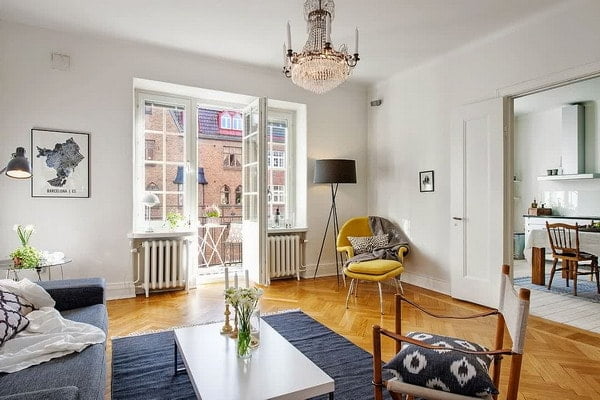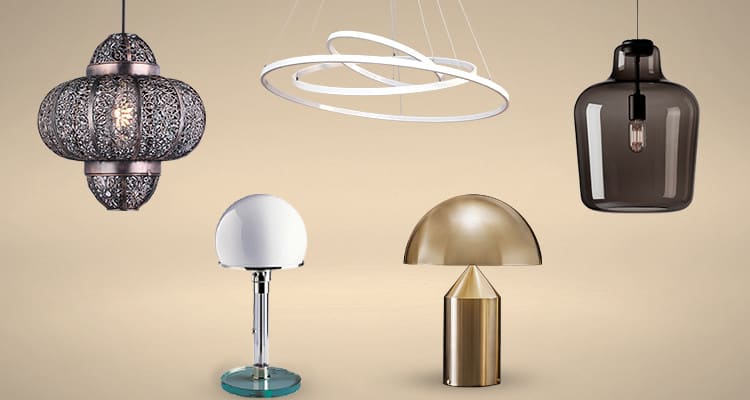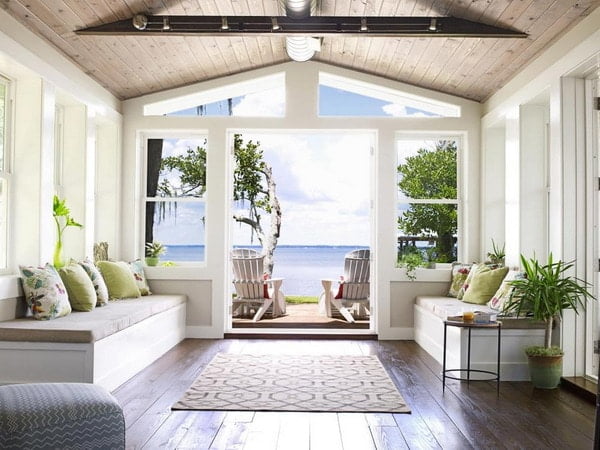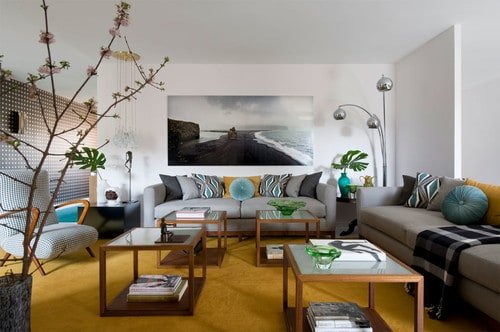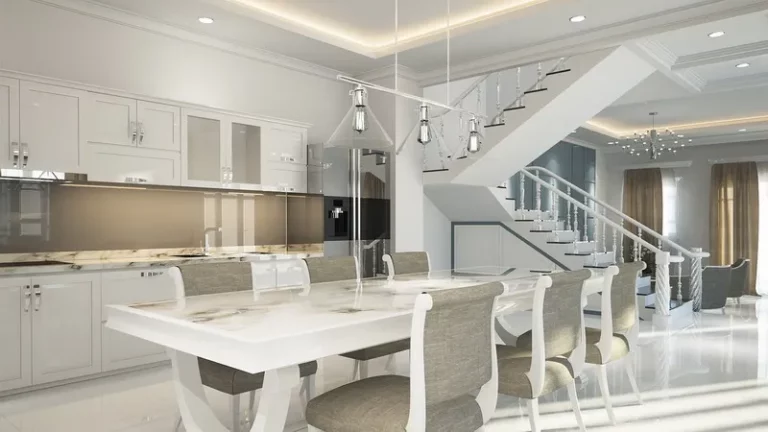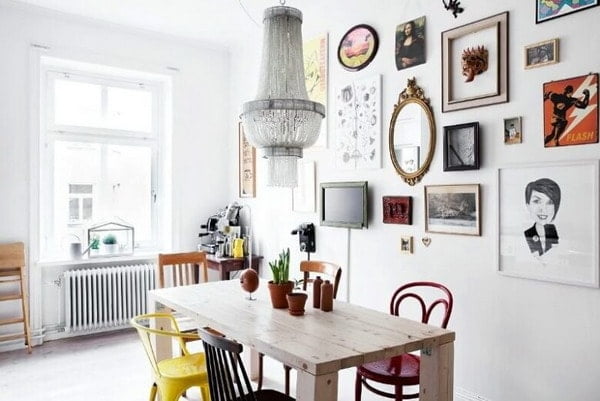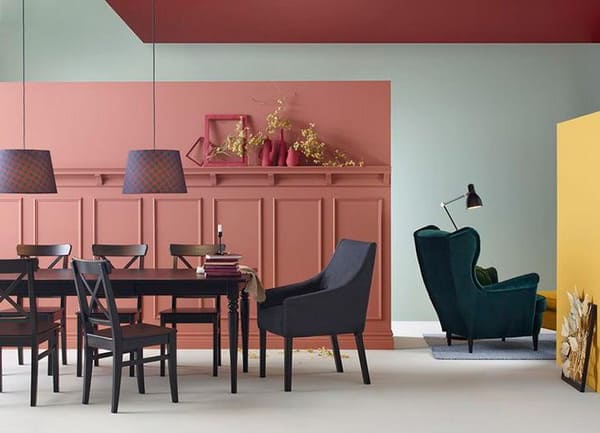What are the main decorating styles 2021
Last Updated on May 13, 2024 by zeidqi
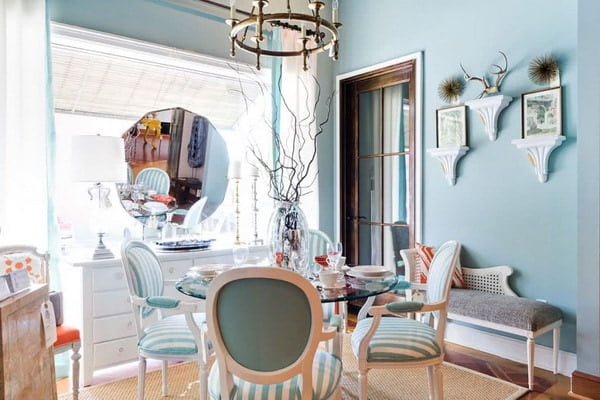 What are the main decorating styles 2021? – not only the specific design of the space, but also the embodiment of the personal preferences of the owners of the room. Stylistics determines the appearance of the home, sets the emotional part of its perception.
What are the main decorating styles 2021? – not only the specific design of the space, but also the embodiment of the personal preferences of the owners of the room. Stylistics determines the appearance of the home, sets the emotional part of its perception.
Also, the selected styles in the interior affect the nature of the repair work that will be carried out in the room. After all, the general concept determines the choice of finishing materials, home decor items, furniture, colors. Therefore, to find out what styles are in the interior, you need anyone who plans to transform a residential or commercial space. To do this, it is worth exploring the characteristic features that describe the styles of interior design, as well as see the corresponding photos with examples.
You should not consider a specific style description as a strict rule. All styles in the interior of the design only set the general concept, within which they stand design, and the direction for the creative thought of the designer. The name of the styles in the interior and their characteristics will help you navigate the variety of designs.
What Are The Main Styles In The Interior: General Information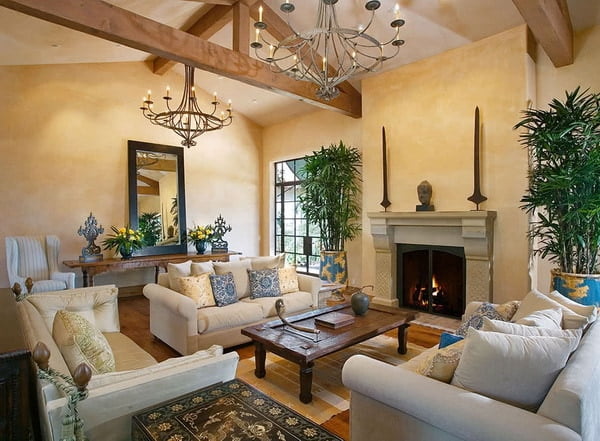
All styles of interior design are divided into three groups. Each of the main groups has a common characteristic, but the styles within its borders differ in a number of ways. What are the groups into which the main styles in the interior are divided?
- Classical (historical) styles in interior design. Classical style is inextricably linked with art and architecture, characteristic of a certain historical period. To create classic interior styles in design, you need to carefully study the specifics of the corresponding era. The classic style is appropriate if the designer has to arrange a large area, and the budget for repairs is above average. The entire list of interior styles included in the classical group implies the use of natural materials, luxury furniture and decor for decoration. Classical style trends are suitable for conservative personalities who do not like experiments and prefer solutions that have been tested for centuries. The list of interior styles related to the classic is large: it is Baroque, Rococo, classic (classic), modern, Gothic, etc.
- Ethnic styles in the interior.These varieties of interior design are based on the specifics of home decoration specific to a particular territory. The country where the style originated determines its name. For example, Moroccan, Japanese, Chinese. Ethnic design is not common. After all, it is not easy to completely recreate the materials, furniture and decor that were used many centuries ago in distant countries. Also, from a historical point of view, pure ethnic design is not found. After all, culture, art and architecture of different nationalities were mixed and influenced each other. For example, the Scandinavian style was influenced by the Moorish. Therefore, the original ethnic interiors cannot be repeated. But ethnic types of interiors today look original and expressive. Ethnic styles of apartment interiors are interesting in small details. This design in which decor plays an important role. In order for ethnic styles of the interior of living quarters to look natural and believable, one must at least have a superficial knowledge of the art and architecture of a certain country, the traditions of its inhabitants.
- Contemporary interior styles- common today. This stylistic trend has been formed over the past 50-100 years. Modern styles in the interior of the house – a fancy design, which often includes classic or ethnic elements. Modern views of the interior of the apartment are open to all experiments with form and color. These interior design styles absorb all the effective and rational ideas from other stylistic directions. As a result, space acquires not only high functionality, but also worthy aesthetic qualities. Modern types of interior designs are designed to create a practical space adapted to the needs of its residents. The names of the interiors of apartments decorated in modern styles are grunge, minimalism, neo-classic, high-tech and others.
So, the main styles of apartment interiors are divided into three groups. But the types of interiors and their characteristics do not end there. Many designers also highlight mixed styles. This design implies that different styles are mixed within the boundaries of a certain space. The mixed style of an apartment or house is kitsch, fusion and eclecticism.
What are the interior styles that are not included in any of these groups? This is a colonial style . It occupies a separate place for good reason. Colonial style combines ethnic and classical features, but at the same time has its own characteristic features. It has survived from the time of medieval England, when there was an active colonization of the African continent. The British came to the black mainland, but did not want to live in huts, and sought to create a familiar and comfortable interior. But it was impossible to completely get rid of the local flavor, and the local decor attracted with originality.
As a result of the mixing of European and African culture, a colonial style appeared. Appropriate furniture styles in the interior are in demand today. Wicker rattan or teak furniture, furniture made of rubber or tulip wood – a distinctive feature that characterizes the colonial style. A typical interior decoration is a carpet made of plant fibers, as well as ethnic figurines, chests, suitcases, ceramic or metal dishes. Design involves the use of animal skins, stuffed animals, horns.
The interior is designed in natural colors: all the restrained shades of green and brown colors prevail. The unusual style acquires completeness and freshness due to the fact that the room is replete with green plants in pots: ferns, palm trees, bamboos.
Antique Style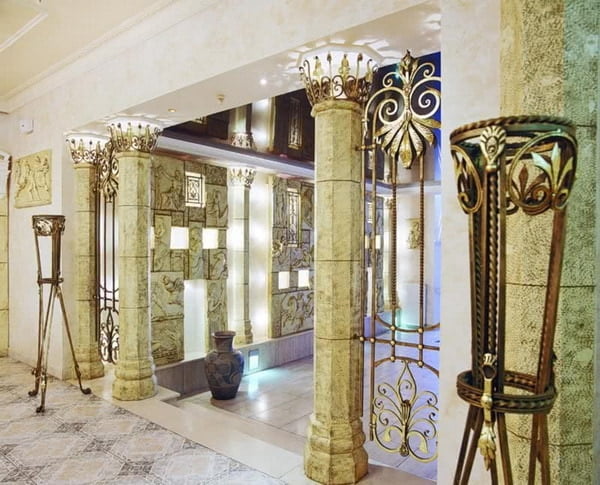
The antique interior reflects the features of art and architecture characteristic of ancient Greece and Rome. Scientists have established that this current began to emerge in the VI century BC. Antique buildings are recognizable: their architecture is proportional and harmonious, and excessive splendor is unacceptable. The interior will be the same, symmetrical and balanced. The abundance of free space, a large area and a high ceiling will be its integral features. The antique interior is impossible to imagine without an atrium: a closed patio, which played the role of the center of the inhabited space. Today, the atrium is replaced by a spacious living room.
- Walls. The interior in the antique style implies drawing attention to light walls: they are decorated with textured plaster, frescoes, tapestries. Antique design styles welcome niches and arches, or marble or mosaic inlays.
- The ceiling of the caisson structure made of intersecting beams with niches between them, decorated with stucco and painting – a hallmark. Combined and domed ceilings will also be appropriate. If the owners prefer a laconic design, matte stretch ceilings are also suitable: then the emphasis needs to be shifted to other interior elements.
- The floor is finished with light ceramic tiles or wooden parquet. The use of natural stone is welcome, as well as surface decoration with chess patterns and mosaics. Nowadays, it is allowed to put a carpet with a stylized ornament in case the floor is plain.
- Furniture is antique or artificially aged – a suitable option. Streamlined shape, decorative details (bent legs, gilding, inlays) – its typical features. Cabinets and shelves are made as invisible as possible, because in ancient interiors they were replaced by chests. There are few pieces of furniture: the antique style is characterized by the laconicism of the decor. The decoration of the furniture also becomes a luxurious silk or cotton upholstery.
- Decorative elements. Sculptures, tapestries, paintings with antique motifs, tall vases will decorate the antique interior. The architectural elements are important: niches, arches, columns, bas-reliefs. Stucco molding and painting are welcome. Ornaments are widely used: the well-known meander, animalistic and floral prints, as well as spiral and wavy lines.
- Lighting. Torch-shaped luminaires fit perfectly into the antique design. Multilevel lighting is appropriate: a large chandelier in the center of the ceiling, combined with illumination of niches and individual interior details.
- Color spectrum. The antique interior involves the use of pastel colors: golden, ocher, sand, olive, pearl gray. The accents are blue, green, black and yellow details. An important role is played by combinations of close shades and midtones.
- Materials The antique style welcomes the use of natural stone, wood, metal, as well as ceramics and ivory. Silk and cotton act as textile elements.
Egyptian Style
Egyptian is considered the basis for the emergence of all other European styles. His echoes are found in Art Deco, Empire style. This stylistic trend is optimal for clubs, restaurants, as well as living rooms or saunas.
- Materials: all natural – exotic wood, ivory, malachite, bronze, turquoise. It is permissible to use their quality substitutes, otherwise the interior will cost an astronomical amount. For example, ceramics, stone.
- Finish. In the original, the Egyptian interior had walls covered with carvings and hieroglyphs. They are replaced by Venetian plaster, wallpaper with appropriate images or a pronounced texture. Architectural elements such as niches, columns or arches will also be appropriate. On the ceiling, attention is not accented. Another option – it takes shape under a starry or cloudy sky. Ancient Egypt also featured thematic flooring. Instead, stone, mosaic or tile are used today. Do not be afraid of shiny surfaces, such as gold.
- Furniture. The interior in the Egyptian style is replete with dark wood furniture, decorated with carvings, linings or gilding. Now it is being replaced by furniture with legs corresponding in shape to the legs of a four-legged animal. The Egyptians were the first people to come up with backs and armrests, so the furniture is not only beautiful, but also comfortable.
- The color scheme – all shades of yellow, as well as pure tones of red, blue, brown, green, white, blue. Blotches of gold, which will make the Egyptian interior luxurious, are welcome.
- Textiles . The Egyptian style uses textiles in limited quantities. Natural fabrics with geometric patterns or plain colors predominate.
- Decorative elements are stylized to those that were used during the existence of Ancient Egypt – figurines and images of sphinxes, Nefertiti, scarab beetles. Jewelery in the form of cats (sacred Egyptian animals), as well as papyrus, vases, mirrors in a gilded frame will be appropriate.
- The lighting is dim, and the light sources are hidden. For example, fixtures can be hidden in the ceiling behind frosted glass or acrylic.
Romanesque Interior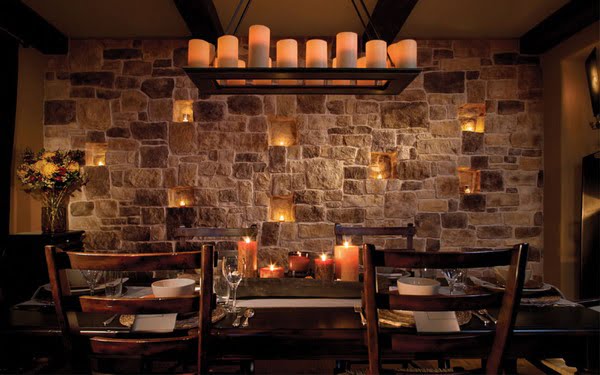
Romanesque style was actively used in architecture of 11-12 centuries. All buildings of that era, which were supposed to withstand many military clashes, had a severe and thorough appearance. Their interior was appropriate. Vivid examples of Romanesque architecture are the French cathedrals of Notre Dame in Poitiers and in Moissac.
- Materials : simple and natural, for example, stone, wood, bronze. Textiles are used with a pronounced texture: linen, canvas, burlap are suitable.
- Finish . A frequent option for additional finishing for the floor is stone mosaic, and the main role is played by large ceramic tiles, aged wood or laminate. The wall cladding imitates stone, and its stern look will be smoothed out by stained-glass windows, wooden inserts, frescoes. The ceiling becomes a visual extension of the wall.
- The furniture has a rough design, and its characteristic item is a chest, which is used instead of a bed, bench and wardrobe. Tall chairs without upholstery, a table, a simple-shaped canopy bed will fit into the Romanesque interior. The corners of the furniture are closed with metal plates.
- The color palette is restrained, but with red, white or gold accents.
- Decorations: frescoes, stained-glass windows, paintings, tapestries, large vases, relief images. Things that are associated with knightly times will fit into the Romanesque design: armor, torches, or coats of arms. It is recommended to equip a fireplace.
- Textiles will help to make the Romanesque interior cozier: carpets with ornaments, different draperies, simple curtains are suitable.
- Lighting. Forged lamps having the form of candlesticks, chandeliers with a wooden base and metal chains are appropriate.
What Design Styles Exist: Classic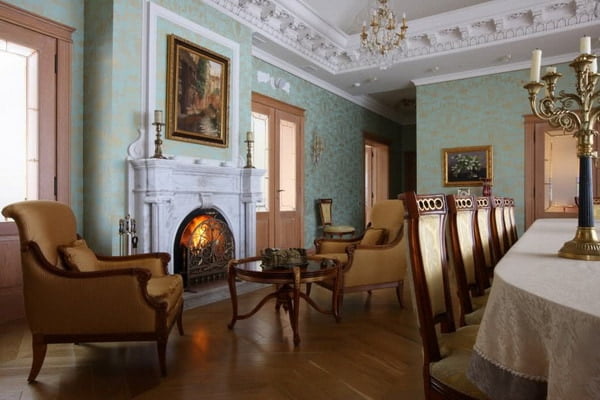
Classical style appeared in the late 17th – early 19th centuries in France. The main landmark for him is antique art and architecture. The classical style differs from Baroque and Rococo in more restraint and conciseness, but retains their solemnity. The classic style in the interior is replete with straight lines and symmetrical shapes. A representative example is the building of the French castle Maly Trianon. The classic style is suitable for conservative and restrained people who prefer a respectable design. Such an interior will never go out of style.
- Materials . The classical style requires the use of expensive materials: natural wood, silk, stone. Replacing such a finish with artificial analogues, for example, a laminate or imitation marble, is unacceptable.
- Furniture. Classical furniture is made of natural wood – walnut, maple, Karelian birch, etc. Carved elements, gilding, inlay, decorative overlays will be characteristic furniture decorations. A common element of the classical style is a mirror in a carved frame, revitalizing a simple interior, as well as a fireplace.
- Colors. The main color palette will be shades of white, gold, blue, green, brown. Pastel colors are also used.
- Decor Decoration of the interior, decorated in the classical style – sculptures, stucco moldings, carpets. Refined architectural details, such as columns and arches, are also typical, and act as a characteristic decor. The walls are decorated with moldings or wood paneling.
- Textile. Natural fabric – an element without which it is impossible to imagine a classic design. The fabric not only decorates the interior, but also gives it integrity. Tapestries, long-pile carpets, furniture covers, multilayer curtains with draperies and lambrequins make the classic interior luxurious. Such textiles as jacquard, taffeta, velvet, silk, organza, tulle, veil, etc. are used.
- Lighting. Classical style means bright lighting, and lighting reminds works of art. They are made of elite glass, crystal or stone. Bronze lamps with shades, lamps, the shape of which imitates candles, will fit into the classic interior.
Renaissance Style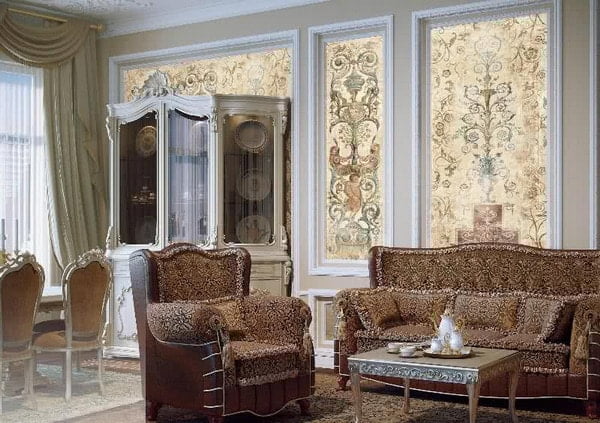
The era of Gothic art in the 15th century was replaced by a renaissance (Italian – “revival”), which subsequently remained relevant for three centuries. The Renaissance marked a new flowering of the arts after the troubled Middle Ages and the beginning of the cult of the human personality.
He found expression in architecture: symmetrical and harmonious buildings in the spirit of the Renaissance are located throughout Europe. This is the Uffizi Palace, the tomb of the Medici family, St. Peter’s Basilica, part of the Louvre Palace and many others. In every European country, the design of the Renaissance had distinctive features that also changed over time. But all the interiors in the Renaissance style were characterized by some common properties.
- Building materials – only natural: elite species of wood, stone and marble, ivory. For a wall, visual division into separate parts is typical. Neighboring areas are distinguished by a different color or texture. Renaissance style welcomes decoration with Venetian stucco, wood paneling, fresco painting. The floor is wooden, stone or marble. The ceilings can be vaulted or caesonic, with stucco or painting, the characteristic plot of which is angels fluttering in the sky. Often there are plant motifs.
- Furniture looks like mini-architectural creations: it is decorated with columns, pilasters, cornices. Its colors are restrained, which makes it possible to focus on the luxurious texture of wood. The beds are high, with canopies and curtains. For storage, capacious chests are used, which became the progenitors of cabinets and sofas. Chairs are also tall, with carved legs and upholstered in leather or velvet. All pieces of furniture are inlaid with decorative inserts or stones, decorated with gilding, painting, stucco molding or carving.
- The color palette can be any, but the characteristic interior is a lot of white and pastel cold tones.
- The decor is widely used: it is multilayer curtains with lambrequins, brushes, paintings with images of people, animals and plants, mosaics on the floor and walls. Mirrors, large vases and candlesticks will be useful. Columns and pilasters act as architectural decorations.
- Lighting. The windows are large, often arched in shape, through which sunlight penetrates freely into the interior. Lighting fixtures imitating candles or candelabra will be appropriate.
Empire Style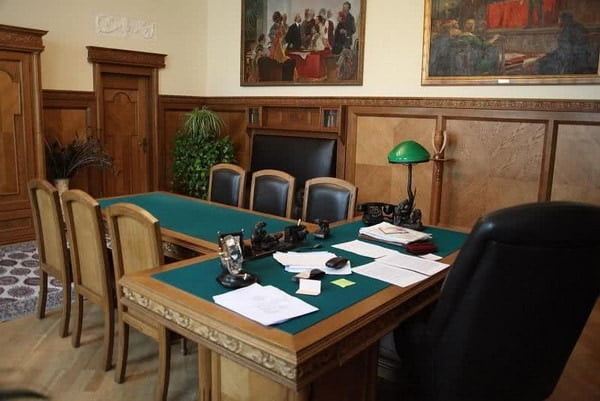
Empire, which is also called the imperial style (from the French. “Empire”), arose in the early 19th century, replacing the restrained classicism. This new trend, which originated in France during the reign of Napoleon, became the embodiment of the motives of the heroic struggle. Such moods, initially manifested in art, then spread to the interior. Military themes, ostentatious luxury, an abundance of decorative ornaments, and gilding make design in the spirit of an empire style solemn and ceremonial.
Empire is characterized by the borrowing of other styles – Egyptian, Greek, Roman, as well as palace. Ethnic details are also noticeable. Empire style – contrasting in everything. In general, the design gives the impression of a magnificent, but simple. It is optimally suited for office buildings.
It combines monumentality with exquisite decorative details, which is reflected in Russian architecture of the 19th century. The country that defeated Napoleon was still interested in imperial design. This trend became widespread even later, in Soviet times, having gone down in history as the “Stalin Empire”.
- Building materials are used of natural origin: marble, dark wood (wenge, black walnut, etc.), crystal, bronze.
- Textiles : multilayer curtains of complex design, decorated with lambrequins, scallops, folds, fringe. Velvet in combination with organza or silk will be appropriate.
- Furniture – symmetrical shapes, with smooth bends. The legs often look like animal paws, the armrests are also supported by carved curls or animal figures. A round table, soft chairs, couches, sideboards are typical pieces of furniture, without which it is difficult to imagine the Empire style. Leather or velvet upholstery is welcome.
- Finish . On the walls are wooden or bronze panels, but elite wallpapers, such as silk, are also acceptable. Ceilings can be coffered, and parquet or stone is used to finish the floor.
- Color palette. The main color, without which it is problematic to imagine an imperial design, is all the saturated shades of red combined with gold. Other tones are allowed, the main thing is that they be bright, noble. Contrasts are welcome, a common example is white with red.
- Decor – military subjects: weapons, shields, helmets, pennants, paintings with battles. In the framework of the Empire style, stucco molding with laurel wreaths, animal heads, as well as hides and bas-reliefs are used.
- Lighting. The design of the lighting fixtures is intricate, close to candelabra. The best choice would be bronze lamps decorated with crystal pendants. Fabric shades are acceptable.
Biedermeier Style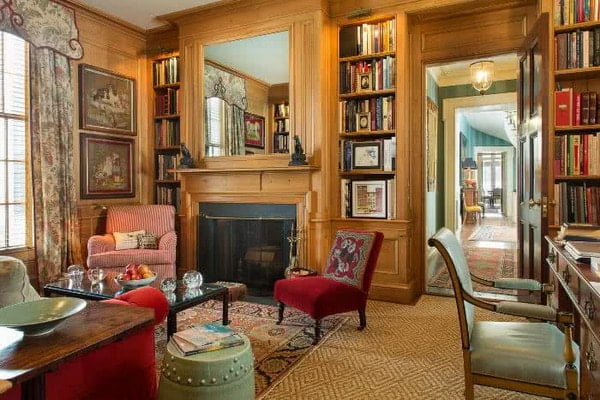
Biedermeier is an interior style where representatives of the Austrian middle class lived in the middle of the 19th century. Its main feature is moderation, combined with functionality and a degree of sentimentality. This movement became so called by the name of a literary character from verses popular in those days. This hero embodied a typical image of the Austro-German inhabitant.
Biedermeier’s heyday left few examples of architecture. These are mainly small suburban estates. One indicative example is the two-story Tegel Castle in Berlin, modest on the outside, but adorned with Hellenic details inside. This combination may seem unexpected, but it is justified. After all, Biedermeier appeared as a negative reaction to the inconvenience of the Empire, but at the same time retained its basic features. Biedermeier is homely and relaxing.
- Furniture is characterized by softly curved forms of backs and armrests, chiseled legs that look like animal figures or with plant motifs, upholstery with flowers or stripes. Practicality comes first, and then decorativeness. Light wood prevails, the veneering technique is widely used. The traditional attributes of Biedermeier are a large round table, a glass sideboard, and whatnots.
- Materials and finishes are standard: paper wallpaper, plaster, paint. The walls are plain, mostly warm tones. The wooden floor and white ceiling also do not attract attention. But a modest stucco molding or cornice is acceptable on the ceiling. It is permissible to use artificial substitutes for natural building materials: for example, laminate, chipboard.
- Jewelry. The interior of the Bidermeyer comes to life thanks to the abundance of green plants, photo frames, miniature figurines, herbariums, wall or floor clocks, embroideries. Pictures will be useful: “naive art” will fit into the style, where cute everyday scenes become the subject of the image. For example, family walks, talking with animals, etc.
- Textiles are present everywhere – colorful tablecloths and bedspreads, embroidered wraps, napkins, curtains with draperies and tassels. One long-length small carpet on the floor or a canopy above the bed will also be appropriate.
- The color palette is restrained, warm. These are unobtrusive shades of brown, green, crimson. In the bedroom, let’s say blue, pale pink. Neutral gamut is diluted with rare color accents.
- Lighting contributes to the creation of cozy and secluded corners, for example, for reading or needlework. Therefore, various lights with and without lampshades come in handy. Chandeliers can be moderately decorated with crystal or glass pendants.
Art Nouveau Style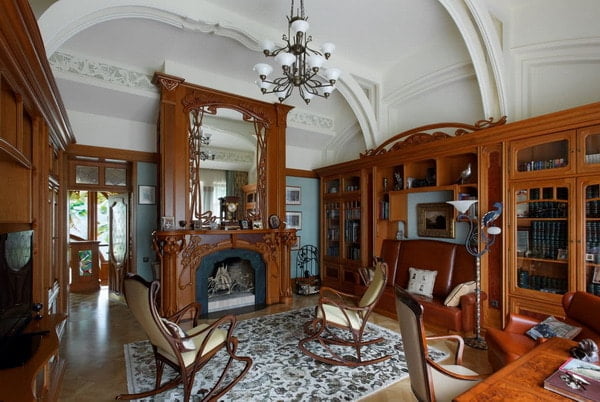
The flourishing of Art Nouveau in art and architecture came at the end of the 19th – beginning of the 20th centuries. One clear sign of Art Nouveau is curved lines and smooth forms, thanks to which the interior looks like a whole, where there are no clear boundaries. Art Nouveau design at the same time gives the impression of being fantastic and aimed at bringing people closer to nature. Recognizable and modern architecture. Natural shapes prevail in the outlines of buildings, but at the same time, concrete, glass and metal are widely used. Right angles in Art Nouveau buildings are rare, as is full symmetry. Art Nouveau interiors also have these characteristics.
- Materials Art Nouveau is considered a style, the implementation of which requires substantial material costs. Indeed, despite the permissibility of glass and metal, natural wood is considered an obligatory attribute. Art Nouveau also welcomes the presence of natural stone.
- Walls, floor and ceiling. Walls play the backdrop for a luxurious setting without focusing on yourself. They are painted in neutral or muted tones. But Art Nouveau in the interior allows a discreet floral ornament on the walls or the division of their surface into two parts, when the lower half is finished with decorative panels of wood. Art Nouveau is distinguished by an exquisite ceiling design: gypsum stucco molding, decorative wooden elements of a fancy shape, stained-glass windows. But Art Nouveau implies a restrained finish of the floor: stone, tiled or wooden coating of natural tones that match the walls or darker them.
- Furniture is distinguished by sophistication and non-triviality, the absence of sharp corners and the predominance of streamlined shapes. Modern means the widespread use of forged and carved elements. The naturalness of color and material is one indispensable feature of furniture. Its fabric upholstery is restrained, attracting less attention than basic material, such as wood. There are few objects, because the modernist interior obliges to a sufficient amount of free space.
- Color range. A competent choice for the modernist interior – muted and complex tones. For example, shades of lilac, pink, gray, swamp, olive with a silver or golden tint. Art Nouveau admits among the natural gamut individual bright elements that make the interior deep.
- Tissues. Any kind of textile is an interior element, without which it is impossible to imagine modern. A combination of plain fabric and textile with floral ornaments will be a win-win. One important point: Art Nouveau implies that floral motifs are always directed upward, imitating the natural growth of plants. Embroidery, golden cords, fringe, drapes of complex shape are decorative elements that adorn textiles.
- Decor . Art Nouveau is a decorative style in which all interior items play the role of its decoration due to their intricate shape. Lamps and textiles are considered traditional for him. The room will be transformed if you install in it a fireplace of an unconventional shape, for example, a round one, or an aquarium, where the fish will swim in the middle of wriggling algae. A characteristic print for Art Nouveau is a sophisticated floral, animal, as well as images of girls with flying long hair. Art Nouveau is also inseparable from decorative stained-glass windows. They decorate windows or other objects, such as lamps.
- Lighting. Art Nouveau welcomes the use of frosted glass chandeliers and sconces decorated with floral motifs. Candelabra will also be appropriate. One characteristic feature of Art Nouveau – lamps in the Tiffany style, that is, decorated with stained-glass windows. Crystal or forged elements, metal parts with a gold dusting effectively decorate lamps.
Baroque Style In The Interior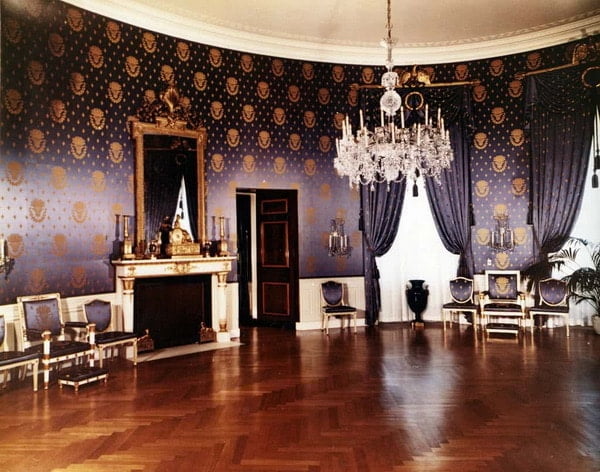
The heyday of baroque came at the end of the XVI – the middle of the XVIII centuries. Initially, it appeared as a papal style in the Vatican, but quickly spread outside Italy, penetrating the architecture and art of other countries. Famous Baroque buildings – Winter Palace in St. Petersburg, Church of San Carlo alle Cuatro Fontane in Rome. Baroque architecture is replete with complex curvilinear forms, characterized by spatial scope. For this direction as a whole peculiarity and solemnity are characteristic.
Baroque style is suitable for those who believe that the interior should demonstrate a high level of prosperity, and strives for ostentatious luxury. But such a pathos atmosphere would be appropriate if a spacious private house or at least a two-level apartment is at your disposal.
- Materials used are natural. The baroque interior is replete with stone and wood, which are used to finish all surfaces – not only the floor and ceiling, but also the walls.
- Furniture is convex-concave in shape, often varnished. The beds are decorated with lush draperies, sofas, tables and chairs with bent legs. Headsets of upholstered furniture upholstered in expensive textiles are also used. A common sign for all Baroque furniture is emphasized decorativeness and pretentiousness.
- Walls, floor and ceiling. As part of the Baroque style, the walls are decorated with arches, paintings, divided into separate fragments using moldings. Ceiling – with decorative stucco elements, images of angels. Parquet is laid on the floor.
- Color spectrum. The baroque interior is decorated in light colors: white, gold, light green and blue. But bright details are acceptable.
- Decor is an element of baroque, thanks to which the interior acquires the necessary degree of pomposity. The furniture is decorated with ornate ornaments, gilding, stucco molding or painting. Floral patterns prevail: flowers, leaves or tree branches. The room is decorated with tapestries and carpets, figurines and bas-reliefs, vases. The baroque interior is impossible to imagine without large mirrors in luxurious frames. Another hallmark is the frescoes in the decoration of the walls and ceiling.
- Tissues. Curtains with multilayer draperies and lambrequins become a real decoration of the room. Baroque welcomes the contrast of textile textures, such as velvet with tulle or organza. Widely used lace and silk. Baroque style also welcomes embroidery and printed images on textiles.
- Lighting is subdued and comfortable. A chandelier with bulbs in the form of candles, lamps imitating candlesticks will fit into the interior of the baroque. It is better to refuse fluorescent lamps, but prefer lamps with textile lampshades or multi-color shades.
The baroque interior requires a great taste of the designer. Otherwise, the space will only be filled with expensive items that are not compatible with each other.
Rococo Style In The Interior
Rococo (from the French – “sink”) is a direction that appeared in France at the beginning of the 18th century and quickly spread to other countries where it dominated until the end of the century. This style, popular among royal favorites, is considered feminine in connection with its decorativeness and playfulness.
The interior of Rococo, where straight lines and flat surfaces meet, is nonsense. Even the columns have a twisted shape, a reduced or increased height compared to the standard.
Sometimes there are too many ornaments, stucco moldings, gildings, and murals, so the interior is balancing on the verge of bad taste. Palaces of this period, for example, the Dresden Zwinger, the Palace of Versailles, amaze with ostentatious luxury and wealth.
Rococo design has an unusual sign – this is a fashion for China. Today, the rococo style is suitable for those who seek to demonstrate their own viability in all possible ways.
- Building materials and fabrics: exclusively exclusive and natural. Elite options are also suitable: for example, silk wallpaper, wooden stucco on the walls.
- Furniture: its lightweight design, it is characterized by bends, gilding, carving and rounded corners. Dressing tables and secretaries with many secret drawers, large mirrors in gilded frames are common attributes of the interior. There are sofas, the design of which is a few chairs connected together, as well as comfortable sun loungers. The furniture is adapted to women’s needs, in particular, to the presence of magnificent skirts in which it is difficult to sit. Often there is a stylization “for China.”
- The color palette is based on pastel colors, and rich – complement the interior. Pistachio, light blue, lavender, silver, gray pink, coral will be appropriate.
- Ornaments – paintings with mythological and erotic images, artificial and natural flowers, china. The interior is decorated with Chinese screens, aquariums, and elegant furniture is painted with Asian patterns. A characteristic attribute, without which it is difficult to imagine the Renaissance style, is a marble fireplace, on which candelabra, watches, and vases stand. Textiles – ceremonial: curtains of complex cut, decorated with fringe, lambrequins, embroidery. But lightweight fabric is used.
- Lighting – natural, freely penetrating through the window, but a little muffled by the curtains. Bronze or gilded lamps that imitate candles or with large shades are appropriate.
Art Deco Style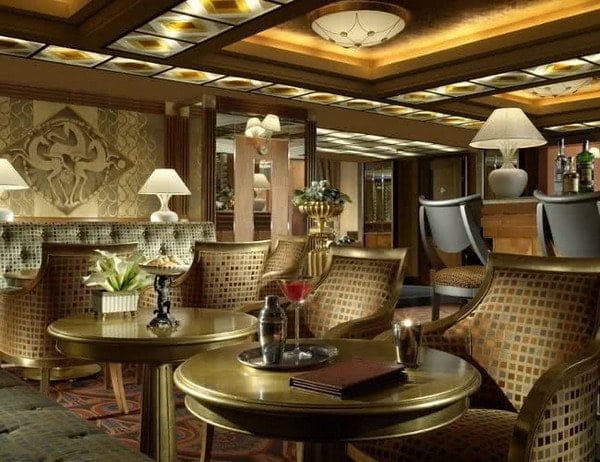
Art Deco – the direction of art and architecture of the first half of the XX century, which became an intermediate stage between modern and functionalism. Many skyscrapers in New York are considered the reference examples of Art Deco buildings: Chrysler Building, Empire State Building, General Electric Building, Chenin Building. This stylistic trend is characterized by a strict regularity, which is softened by ethnic motifs, floral and geometric patterns. Art Deco style combines elegant forms and rational structure. The interior is not a single composition, but a collection of stylish objects. As a result, the Art Deco room is more like an art salon than a living space.
- Materials are all natural : for example, an exotic look of wood and leather, bronze, stone, fur, ivory. A widespread combination of metal with glass.
- Finish. The walls in the Art Deco interior immediately attract attention. So, there is a combination of several types of finishes, for example, wallpaper with wood panels. Venetian plaster, upholstery with fabric or wood are common. The floor is finished with parquet or stone.
- Furniture. The Art Deco interior is replete with streamlined furniture on curved legs, varnished and with many drawers with metal handles. Carvings and gilded elements also often decorate furniture, for the manufacture of which dark wood is mainly used. Upholstery – from genuine leather.
- The color scheme is harmonious, implying a minimum of contrasts. All shades of brown (from ivory to brick), black, pearl, gold are used. But in Art Deco, one and two bright accents are acceptable.
- Textiles in art deco play an important role. Acceptable fabric coating on the walls and ceiling. The interior of Art Deco is complemented by multi-layer curtains, chic tablecloths, textile panels, carpets. Lamps are covered with fabric lampshades, and on sofas and beds there are many decorative pillows in covers.
- Decor Within the Art Deco borders, floral motifs coexist with geometric ones. So, iris is considered a symbol of art deco, so the images of this flower will not be superfluous. A traditional decoration for art deco – vases: stone or colored glass. The interior is decorated with paintings and sculptures, often of human figures in expressive poses.
Japanese Style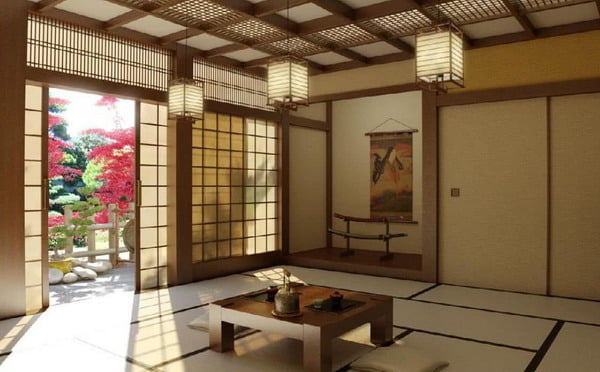
The Japanese style in the interior, like no other, copes with the functional organization of free space. Its characteristic design is concise and soothing. The situation is characterized by maximum orderliness, the desire to recreate natural conditions and graphic.
- Materials A prerequisite is the use of exclusively natural building materials: bamboo, rice paper, stone, clay, silk, cotton.
- Finish. Japanese style means light wall decoration, whether it is textured plaster or paper wallpaper. The lower part can be decorated with wood paneling. Walls will not be the only way of zoning space: they can be replaced by partitions or screens. The floor is finished with wood, and the ceiling in neutral colors can be decorated with beams.
- Furniture in the Japanese interior is present in limited quantities. It is characterized by restrained forms and low height. The bed replaces the tatami, and the chairs with floor cushions. A characteristic item is a rack of complex shape.
- Colors. All colors are from the natural range inherent in the mild Japanese climate. Restrained shades of brown and green prevail. Contrast combinations are rare, white, black or red details are considered acceptable.
- Textile. The Japanese-style interior is replete with textile details: carpets, mats, wall upholstery, screens. The fabric can be either plain or decorated with images of sakura or geisha, landscapes.
- Decorative elements. The Japanese interior does not accept numerous decorations. The emphasis should be on fans, vases, lanterns, green plants. A typical element is a rock garden, ikebana or bonsai. Decorative pillows and bedding in oriental style will be useful.
- Lighting. The Japanese interior accepts both bright and dim lighting. Oriental lanterns act more as an original decoration than a functional light source. But now full-fledged lamps of a similar form are used.
Chinese Style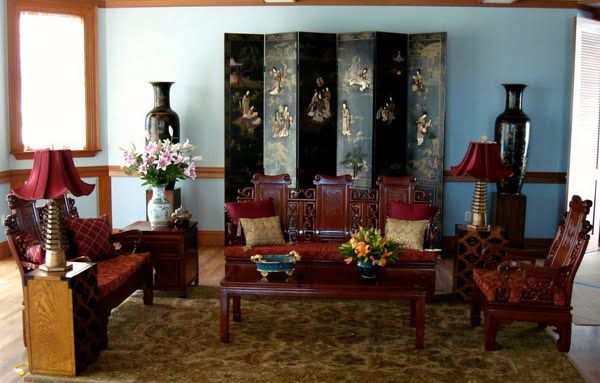
The Chinese-style interior is based on the Feng Shui philosophy, which correlates the harmonious organization of space with the flow of energy flows in it. The atmosphere looks expressive, but at the same time pacifying. Sharp corners and sharp lines are almost completely absent. But, along with philosophical points, the interior has specific signs.
- The materials used are natural, creating an atmosphere of exclusivity. Dark wood, metal forging, silk, porcelain are welcome.
- Furniture – mainly dark, lacquered. It is generously decorated with exquisite paintings, wrought iron elements and gilding. Complex objects prevail, for example, on bent legs or with many drawers. A common element is a screen.
- Finish . The floor is finished with dark wood, and the walls with light paper wallpaper, textured plaster, or painted in pastel color. The ceiling can be either concise or decorated with wooden beams.
- The color scheme is contrasting: white, black, red, as well as pure tones of green, blue, yellow.
- Decorative elements are represented by textile wall panels, fans, ethnic dishes, lanterns. The Chinese style in the interior welcomes the presence of living plants and Feng Shui objects. Among the ornaments characteristic of the Chinese style are flowing geometric and floral.
Minimalism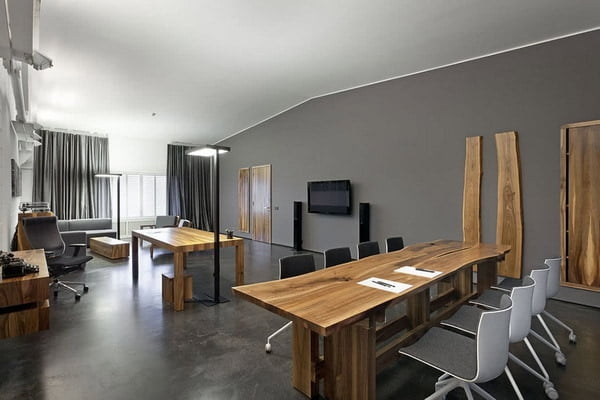
Minimalism arose as a result of a combination of the principles of constructivism and the philosophy of the Japanese style, as a contrast between bourgeois luxury. Therefore, simple forms, small volumes, and neutral tones are characteristic of it. Sustainability and simplicity distinguish minimalism from others. A calm and restrained interior, where there are no extra items, is conducive to relaxation. Even one detail in the setting, selected out of place, can disrupt the harmony of minimalism.
- The materials used are simple and textured, often unprocessed: wood, plaster, brick, concrete. But moderate use of reflective surfaces is also welcome: glass, mirror, metal. Indeed, the style of minimalism implies the presence of a maximum of free space, and glossy textures visually expand the boundaries.
- Furniture – of a laconic form: without sharp corners and plastic lines. An ideal option would be an apartment where all the furniture has the most similar design. Mostly it is low, with light upholstery.
- The color palette is natural and soft, without bright patches. Light shades of beige, gray, as well as white prevail. Contrasting combinations in a minimalist interior are unacceptable.
- Decorative elements are used to a limited extent: the decoration of a minimalist interior is vases of strict forms, pillows, living plants, fluffy carpet. Pictures in simple frames will also be appropriate. Many trinkets and accessories – this is what style categorically does not accept.
- Lighting is important for minimalism: the room should be bright and airy. Therefore, the curtains are replaced with metal or fabric blinds, and the number of partitions that impede the passage of sunlight is minimized. Lighting devices are almost imperceptible. Hidden lighting is welcome, for example, around the perimeter of the ceiling.
Hi-Tech Style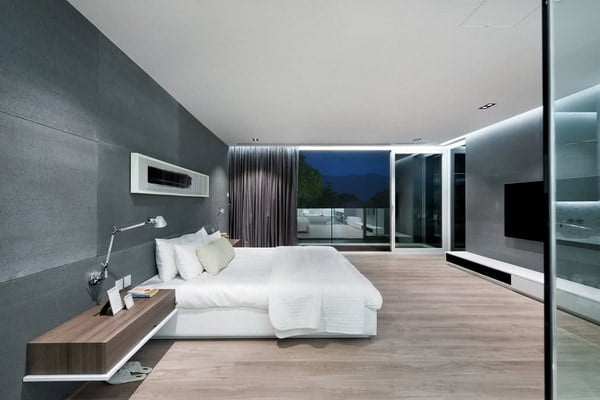
The hi-tech interior is a high-tech design where technical innovations are necessarily present. A living room designed in this style is unlikely to be comfortable. But functional and practical – yes. High tech is preferred by people living without a family. Often it is used for restaurants or clubs. Industrial equipment, wires, pipes, household appliances are not hidden, but displayed, making it an integral part of the situation. A representative example of high-tech art and architecture is the Pompidou Center building in Paris. The hi-tech interior evokes associations with the interior compartments of the spacecraft.
- Materials – mainly concrete, glass, metal, but moderate use of natural brick, stone, wood is allowed. Any kind of plastic is widely used – from flexible to heavy-duty. The fabric is introduced into the interior in a limited way, only to emphasize its cosmicity.
- Finishing the floor, walls and ceiling can be any, most importantly – compliance with the principle of technogenicity. Shiny surfaces prevail. In general, the finish does not attract maximum attention, the emphasis is on other interior items.
- Furniture – geometric shapes, without intricate bends and decorations, and resembling an office. It can be made both from light synthetic materials, for example, transparent plastic, and from more solid ones – leather, chrome pipes. It is unacceptable to furnish a hi-tech interior with traditional cabinets and shelves: they are replaced by racks.
- The color scheme is dominated by strict and neutral: black, white, gray, beige. But individual bright accents of pure tones are acceptable: green, red, yellow, blue. In general, the high-tech interior should look restrained.
- The decor is practically absent: it is replaced with rivets, connecting elements, shiny glass details. The main decoration of high-tech style is the play of light and shadow.
- Lighting is plentiful: both natural, freely penetrating through large windows, and artificial. High-tech lighting also adorns the hi-tech interior. It can be spotlights, spotlights, mobile lights moving along a special bus. Their design mainly uses white or colored glass with metal elements.
Loft Style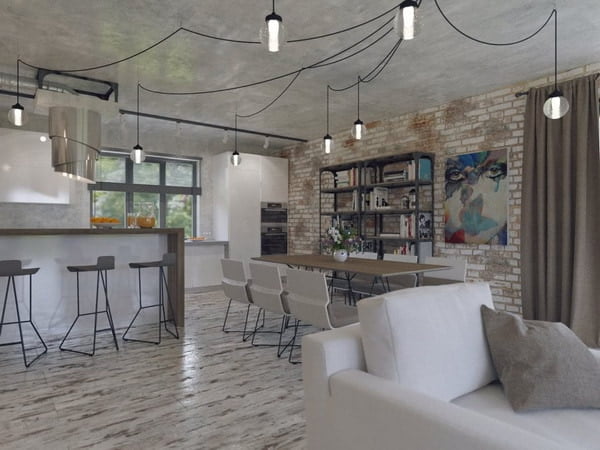
Such a direction of design as a loft originated in America at the beginning of the last century. So-called industrial areas, converted into living spaces due to the high cost of real estate. Mostly people of art settled in lofts, and soon inhabited attics and workshops began to be perceived as places with a bohemian atmosphere. Exhibitions were often held here: such use of lofts was facilitated by their high ceilings, large area, and plenty of natural light. Over time, this unusual housing began to rise in price, and free artists could no longer afford the luxury of living in it. Lofts have become prestigious offices, restaurants or galleries.
- Materials are used with expressive texture – genuine leather, metal, brick. The use of glass is also welcome.
- Finish. Brickwork on the wall, concrete floor or ceiling are integral features of the loft. If an ordinary brick seems too brutal, then paint it in a light color. The ceiling is either white or cement. It is recommended to finish the floor with a natural board with the effect of aging.
- Furniture can differ significantly in design – both to be antique and ultramodern. Refined vintage objects against a background of rough textures look even more expressive thanks to the created contrast. Loft style is difficult to imagine without a leather sofa, shelving or open shelves. There are many places to sit, there is a coffee table. But in general, the situation is concise. Cabinets are rare. They are replaced by open hangers, chests of drawers or racks.
- The color scheme is not limited to specific rules.
- Decorative elements are introduced sparingly. It is better to use one really interesting decoration than a lot of average ones. The loft style, open to experimentation, allows both an African figurine and a woolen carpet. Textiles that smooth the brutality of the loft are also appropriate. It can be pillows, furniture covers. But curtains replace blinds.
- Lighting is important, but there are no restrictions on the choice of fixtures. Both a luxurious crystal chandelier and lighting fixtures that move along special guides on the ceiling will be appropriate. The main thing is to use enough light so that the apartment or house does not look gloomy.
Kitsch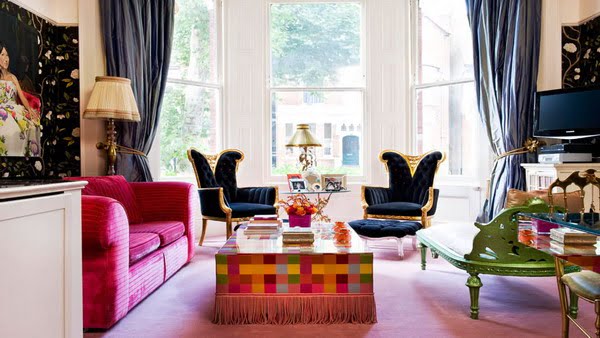
The kitsch-style interior is a prime example of mixing different directions. An important role in it is played by decorative details. Translated from German, “kitsch” translates as “bad taste, cheap stuff.” Often the owners of the home where this style reigns are not even aware of this fact. It is worth being carried away by elaborate and plentiful decoration, too bold combination of tones and textures – and the style of kitsch is guaranteed. The kitsch style is also formed where personalities who fundamentally neglect rules and authorities live.
Kitsch design combines incongruous objects and phenomena, and denies existing stylistic and cultural rules. The inhabited space of the Soviet type, decorated with crystal and gilt dishes, carpets, gypsum figurines, also applies to kitsch. The main sign of kitsch is redundancy in everything.
This style appears due to lack or oversupply of funds. In the first case, random things accumulate in a certain area, and in the second case, the owners strive to equip a “rich” interior, filling it with all the best and immediately. But occasionally such a design becomes a thoughtful work of art, acting as an ironic mockery or denial of the rules. This is the so-called “art kitsch.”
- Materials – mostly cheap, acting as a substitute for natural: synthetic textiles, particleboard, oilcloth, gypsum.
- Finishing is not limited to any rules.
- Furniture – both new, bought in inexpensive chain stores, and vintage. For example, an antique chair can be painted in bright color or decorated with colored tape.
- The color scheme is any, but disharmonious and flashy. Shades do not mix well with each other without creating a single palette. Frequent option: red with gold.
- Decor – often with the prefix “pseudo-“: gypsum columns, stucco moldings instead of marble elements, plastic curls on furniture instead of wooden, home fountains. There are many decorations in the house, and all of them are designed to create the impression of a high social status of its owners.
- Lighting: bright, and as lighting fixtures, a strict chrome lamp on the table and a chandelier with glass pendants can also adjoin.
Pop Art Style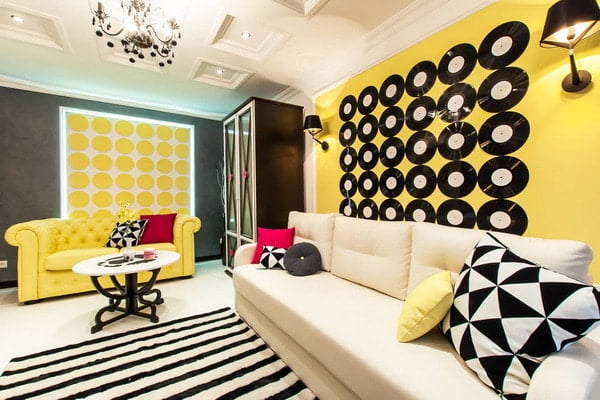
The name “pop art” comes from the English. popular art, that is, “popular art”, or from the onomatopoeic word pop, that is, “pop, explosion.” This modernist trend originated in the 60s. 20th century in America and the UK. Its famous representatives are Andy Warhol, Jasper Jones, Roy Lichtenstein and others. Pop art is a combination of mass production items: from photocopies and comics to finished furniture, which go into the rank of art. A sign of pop art is the desire for sensationalism, provocativeness and uniqueness. Games with visual perception of the selected object are welcome: changing the scale, proportions, color, copying it.
In the heyday of pop art, cult things of mass culture appear, for example, the well-known image of Marilyn Monroe, or cans of Campbells soup made by Andy Warhol. Pop art architecture is small forms: for example, city pavilions.
The interior of pop art will suit creative people who seek to surprise others. The style will be appropriate in cafes, children’s studios, creative offices.
- The materials are dominated by glossy: acrylic, plastic, laminate, glass. But in order not to overload the home, matte, textured surfaces must be present.
- Wall decoration is preferable neutral, with catchy accents – large paintings, posters, panels. Niches are allowed in which one unusual object will be placed, for example, an extravagant figurine. Multilevel ceilings, floors with catwalks are welcome.
- Furniture is purchased in chain stores: plastic armchairs and chairs, intricate sofas, low tables. Cabinets make it as inconspicuous as possible.
- Decor Any relevant objects of mass culture turn into decorative ones: logos of popular brands, heroes of comics, images of fashionable singers … Multi-colored household appliances and dishes are also able to decorate the interior. Own photos printed on a large scale and placed in a frame will also come in handy. However, any picture you like can be turned into a pop art masterpiece by simple manipulations in Photoshop.
- Color spectrum. Pop art style welcomes acid tones that are on a plain background. But in general, there are no strict restrictions.
- Textiles will make the pop art-provocative interior more comfortable. Pillows on the couch and bed, covers, fluffy carpet, plaid definitely will not be superfluous. The main thing is to maintain the overall style.
- Lighting is bright, acceptable and neon. Actual lightboxes, searchlights, chrome or plastic lamps of various shapes harmoniously fit into the style of pop art. Textile lampshades with geometric or abstract prints will also come in handy.
Grunge Style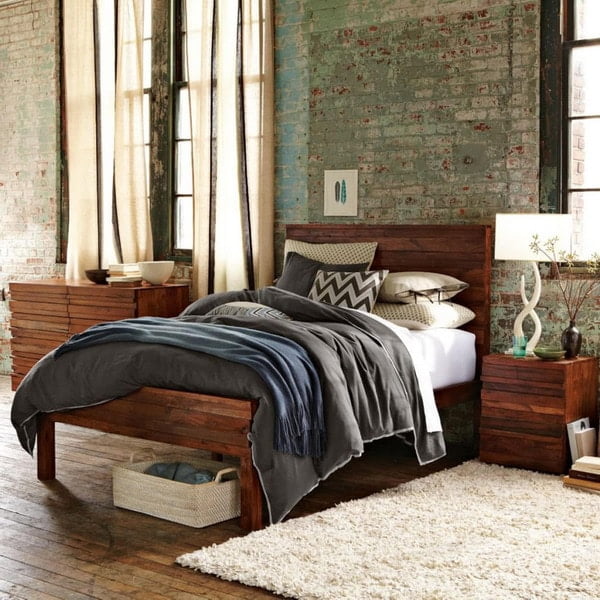
At the heart of the grunge style is a classic, but in a lightweight form. This trend originated in the 19th century in the French provinces. The local bourgeoisie moved to the suburbs for permanent residence, which, tired of city life, strove for silence of family estates. This explains the form of grunge: simplified, but still retaining some elegance and sophistication.
Grunge architecture is mainly suburban houses and other small buildings, harmonious and large-scale, but devoid of decorative elements such as columns and stucco moldings.
In this form, grunge design will exist for more than a century. But the style gradually transformed, and by the 80s. Of the 20th century, he became defiantly careless and bohemian. Its main principles were the rejection of unnecessary pathos and the cult of things, laconicism and ease.
- Natural materials are used, bearing a clear imprint of time: shabby brickwork, wood with minimal processing, plaster with a pronounced texture. Stained glass, glass and mirrors are welcome. Let’s say concrete, high-quality imitation of stone.
- Textiles – simple, without catchy patterns. It can be silk, satin, wool, cotton, linen. Bedspreads, rugs, floor carpets will make the grunge interior more comfortable. Curtains on the windows are single-layer, without extra folds.
- Furniture – intentionally aged, often with glass or laconic forged inserts. Light tones prevail. Mobile designs are relevant. Open shelving, light chairs, wardrobes with louvred doors, mobile tables will be appropriate. Often there is a corner sofa.
- The color palette is restrained pastel shades, soft gray and brick brown. Saturated and contrasting details are acceptable, but their colors should be dusted, reminiscent of the influence of time. The grunge interior is revived with patinated gold or silver accents.
- Lighting is moderate: it is necessary to avoid a gloomy atmosphere, but not to go into excess brightness. Concise lighting fixtures, for example, small wrought iron chandeliers, compact wall lights, floor lamps.
- The decor as part of the grunge is used by designers in a minimal amount, because this style is expressive in itself. One or two paintings, ikebana or living plants are acceptable.
Constructivism Style In The Interior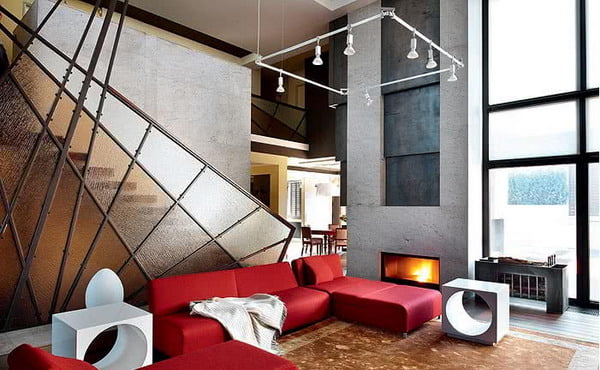
Constructivism originated at the turn of the 19th and 20th centuries, and its basic principle is the paramount importance of design, not composition. The style radically denied the decorative romance inherent in Art Nouveau, and affirmed functional solutions and rationality in everything. This style is democratic and accessible to the general public. The Eiffel Tower in Paris is considered a typical example of constructivism architecture, many buildings of the 30-40s built in the USSR, for example, the ZIL Palace of Culture or the People’s Commissariat in Moscow.
- Traditional materials are used – metal, stone, wood, glass, and their surface excludes the presence of carvings, gilding, etc. The interior becomes deeper due to the textile without ornaments. Acceptable synthetic materials are acceptable.
- Walls, floors and ceilings are plain, and the ceiling design is with beam structures.
- Furniture – strict and simple forms. From an aesthetic detail of the interior, it turns into a purely utilitarian item for sleeping, sitting, etc. Modular, wireframe, embedded models are widely used. Another sign is the lattice shape and visual division into cells.
- Lighting is appreciated naturally, therefore it is recommended to equip panoramic windows and provide an opportunity of an exit to a terrace or a balcony. Curtains should not block the path of sunlight, so it is better to replace them with blinds or roller shutters. All lighting fixtures are of regular geometric shape.
- The color scheme is the prevailing light and clear tones: white, gray. They are diluted with metallic shades, red, yellow, black. In general, the palette is solid with a small number of color accents.
- Decor is used minimally. It is replaced by a play of light and shadow. But let’s say one poster on the wall or an abstract picture, living plants.
Cubism Style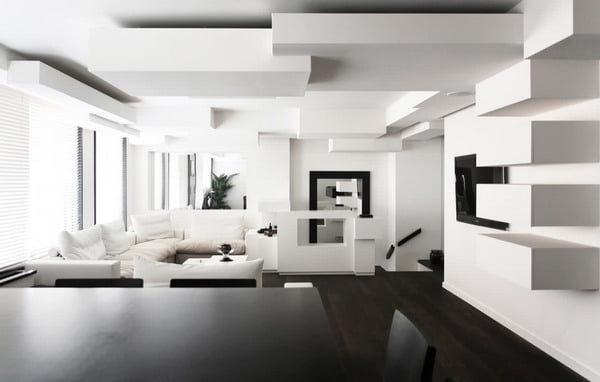
Cubism, which appeared in the 1st half of the 20th century, is based on constructivism. But his new principle is the separation of complex forms into simple, most stable. The interior becomes a space for formal experiments. Cubism style allows the use of inexpensive materials, and is generally considered democratic.
Avant-Garde Style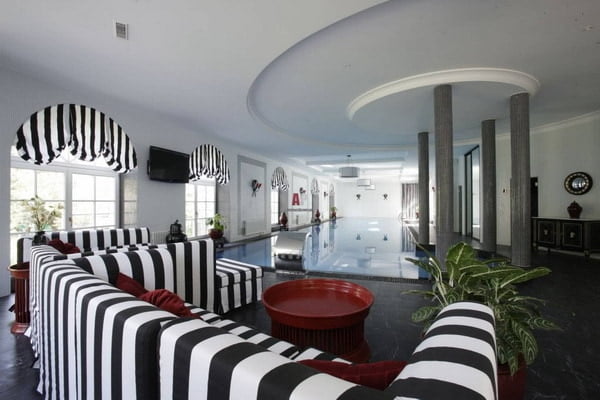
The avant-garde arose at the beginning of the 20th century in Russia as a direction propagandizing the rejection of everything banal in favor of the individual. The avant-garde interior is characterized by fluidity of forms, so the absence of conventional doors and replacing them with partitions, arches, openings is recommended. The presence of podiums, smooth turns, spiral staircases is welcome.
The avant-garde interior is symbolic and artistic, going beyond the usual aesthetics. The emphasis is not only on contrasting color solutions, but also non-standard forms. But, despite the expressiveness and originality, the avant-garde is perceived as a harmonious style.
Avant-garde architecture is such metropolitan buildings as the Mausoleum of them. IN AND. Lenin, Shabolovskaya television tower, State library. V.I. Lenin and many others.
- The materials used are high-tech – plastic, the latest paintwork, decorative plasters. Not without glass, metal. A vanguard design uses traditional stone or brick to a lesser extent.
- Finishing: strict restrictions are not imposed on the choice of coatings for floor, walls and ceiling. But it is recommended to accent or decoration, or home decoration. Otherwise there is a risk to go beyond the boundaries of good taste. In decoration, a combination of natural and synthetic building materials is acceptable: laminate and tile, stone and parquet.
- The furniture is allowed to be diverse: both strict, geometric shapes, and non-standard. Built-in wardrobes are invisible, like a berth: it can be replaced by a high mattress laid on the podium. Unusual armchairs and sofas, including frameless, plastic chairs, extendable tables, will be appropriate.
- The color palette is clear and bright colors: red, yellow, green, as well as white and black. Contrast combinations are welcome. But do not forget that the avant-garde interior should remain cozy. Therefore, it is better not to combine more than two or three saturated tones on a neutral background.
- Decor is used to a limited extent, preference is given to large items. One large floor vase, an abstract picture, a set of unusual dishes will be appropriate.
- Lighting – both exclusive lamps created by designers and inconspicuous built-in lamps. Preference is given to models with plain shades: glass, metal or plastic.
Fusion Style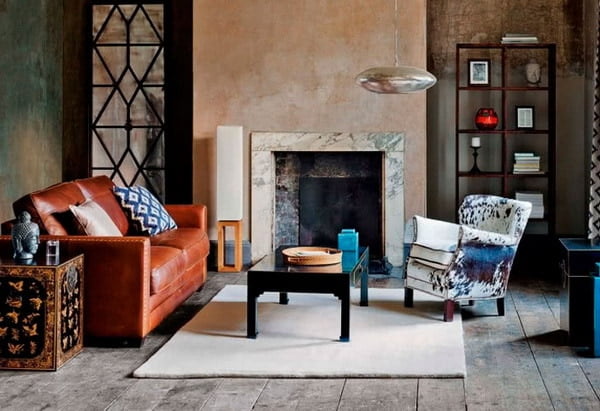
A new direction of fusion (from the English fusion – fusion, alloy, synthesis) replaced the interior styles that prescribed the observance of strict rules. This is a style that arose in the 70s – 90s. 20th century, provides maximum opportunities for creative experiments. Fusion design combines styles that are essentially contrasting – for example, classicism and Egyptian, baroque and hi-tech. But such a non-standard interior still looks thoughtful and holistic.
So that the fusion does not spoil the interior, you should adhere to a number of recommendations. So, this direction is appropriate if the room is spacious, medium or large. It is important and a sense of proportion, so that the synthesis of opposing styles does not turn into a chaotic bad taste.
- Building materials: both artificial and natural. An interesting effect is produced by a combination of different but adjacent textures. For example, relief stucco and glass.
- Color palette. The color scheme is based on neutral tones, for example, white, gray, beige, in which the decoration of walls, floors and ceilings is maintained. Against such a basic background, bright details and color accents look harmonious and not too defiant. Various ornaments are widely used – animalistic, geometric, floral, ethnic, etc.
- Lighting is bright, allowing you to consider every piece of furniture. Often lighting fixtures of non-standard design become an independent decor.
- Furniture can be any, and it is not necessary to comply with the completeness of headsets. So, the interior, where chairs of different collections are combined, is a frequent example of fusion-style design.
Eclectic Style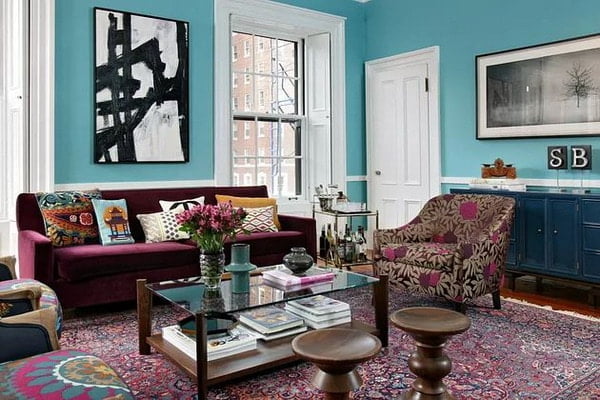
Eclecticism originated in the mid-19th century as a rethinking of the interior styles common in previous years. Eclectic design, in contrast to fusion, combines two or three styles that are close in essence. For example, Rococo and Empire, whose color palette and materials used are similar.
Neoclassical Style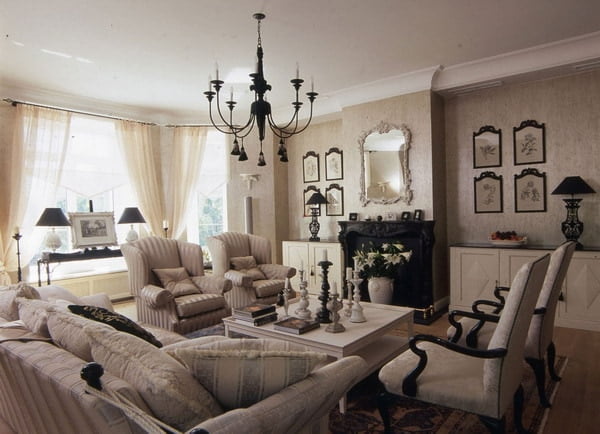
Neoclassic appeared several decades ago. It will suit those who are passionate about classicism and antiquity, but at the same time wanting to keep up with current trends in interior design. Neoclassicism is a combination of the old and the new.
- Building materials: both synthetic and natural. But the interior should make a respectable impression, so do not try to save on decoration. So, both wooden panels and wallpapers with floral ornaments will be appropriate. Permissible caisson, beam ceilings, as well as multi-level suspended structures. Carved ceiling cornices – wooden or plaster. Floor finishing of the floor is also not limited by strict rules: bulk floors, parquet, tile, laminate are acceptable.
- Color palette : Neoclassical interior implies that contrasts are used in limited quantities. The main choice is all the soft shades of white, gray, sand, pearl. The interior will be revived brown, blue, burgundy, golden, black, bronze.
- Furniture – both in the spirit of classicism, with carvings and gilding, and more minimalist. Basic set of furniture for the neoclassical interior: coffee table, soft sofa and armchairs, chests of drawers, cabinets. The presence of cabinets, showcases, consoles, couches diversifies the design.
- Lighting. It is difficult to imagine a neoclassical interior without a large chandelier decorated with glass or crystal drops, metal details. Elegant table and wall lights will also be appropriate.
- Textile. Neoclassical design involves the use of curtains of smooth fabric: satin, taffeta, thick silk, moderately decorated with tassels, fringe, etc. Carpets with floral or geometric patterns are acceptable.
- Decor The main decor for the living room is real or false. Any room will look festive thanks to the presence of mirrors in luxurious frames. Among the decorative architectural details are columns, arches. Living plants will be appropriate in the interior.
Shabby Chic Style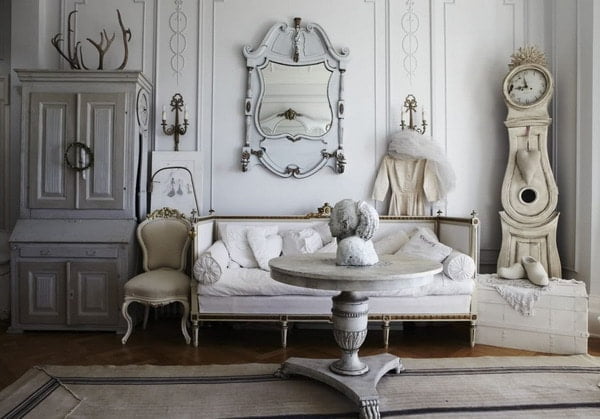
Shabby-chic, symbolizing Victorian romance, was created in the 1980s by designer Rachel Ashwell. Starting with the arrangement of her home, over time, she opened a commercial studio. Shabby-chic, which is translated from English as “shabby chic” – these are vintage or artificially aged things that create a cozy and romantic interior.
The basic principle of shabby chic is tenderness bearing the imprint of the past tense. This decorative style touched only interiors, without affecting architecture and art. There is one more characteristic sign. Style is not intended to collect unnecessary items for anyone. Shabby Chic is based on traditional and quality items.
- Materials: high-quality and natural.
- Finishing is allowed textured, rough. But on the walls, lined with wood, stone or covered with plaster, wallpapers with discreet ornaments are also appropriate. The ceiling is decorated with beams or aged stucco, and on the floor – parquet, tile or laminate flooring.
- Textiles are the most important part of shabby chic: these are curtains, furniture covers, rugs, napkins. They are decorated with fringe, cords or frills. The interior is replete with ornaments. The pattern is different: from pastoral motives to plant ones. Geometric patterns are not allowed, with the exception of a small cell and a thin strip.
- Furniture : all antique or artificially aged. In general, there are many. Forged parts are found.
- The color palette is pastel colors, as if burnt under the sun and dusty: white, ivory, pink, blue.
- Lighting: lamps with fabric or lace lampshades, as well as crystal or glass, emitting soft light.
- Decor: any items that look as if they came from past centuries.
What Interior Styles Are There: Country
The name “country”, which translates as “rustic” combines many stylistic trends. The characteristic features of each are determined by the country where the style originated. Country-style design conveys the design of a rural house in the spirit of the area where it is located. Also, the country style is comfortable and cozy, with some romanticism.
This type of country as the Scandinavian style originated in the northern countries: Norway, Denmark, Sweden, Finland, Iceland. This style in recent years has been at the peak of popularity due to its democratic nature and openness to any experiments.
- Materials Scandinavian country – furniture is made of simple wood: pine, beech, birch. In Scandinavia, multilayer plywood was invented, which made it possible to produce furniture of intricate shapes. Different materials are used: faux and natural fur, linen, cotton, leather. But no matter what type of material is chosen for country, the first place when choosing it is environmental friendliness and comfort.
- Finish. The Scandinavian country style allows wallpapering in small prints. Also acceptable wall decoration – plain wallpaper for painting or textured plaster. Country style accepts wall decoration with clapboard. On the whole, country is welcomed by a simple wall design that does not focus on itself as much as possible. Floor design – natural wood, high-quality laminate or plain tiles.
- Furniture. Country style, which originated in Scandinavia, involves the use of simple and functional furniture, not without sophistication. Light furniture prevails, often wicker or with carved elements. A characteristic element is a comfortable armchair. Used and solid vintage furniture. If necessary, such furniture is repainted or covered with covers made of printed or plain fabric.
- Colors. One primary color for this style is all shades of white: from grayish to ivory. Other light colors are also used: beige, gray, pastel shades of green and blue. Bright accent details dilute some monotony of the interior.
- Decor A variety of decorative elements are considered a highlight. Textiles occupy a special place: curtains, covers on furniture and pillows, rugs, hides, woven rugs. Walls without decorations are rare. Many posters, photos, picturesque images, signs will enliven the room in a country style. Also, the interior is transformed by living plants.
- Lighting. Initially, a residential building in the Scandinavian countries is a room characterized by a lack of natural light. To compensate for this feature, the windows are made large, and the curtains on them are translucent or do not hang at all. This style welcomes the use of multi-level lighting: from a chandelier with several bulbs to a miniature lamp with a lampshade, standing on the bedside table. As a result, a residential building or apartment looks bright and airy.
Mediterranean Country Style
The style originated in the Mediterranean countries: Italy, Greece, Spain. It combines urban and rural areas. The Mediterranean style is warm and bright, but functional. An apartment by the sea or a rural holiday cottage designed in this style will look especially harmonious.
- Materials This branch of country involves the use of natural wood, stone, ceramics, metal as forged elements. The interior is replete with natural fabrics, such as cotton or linen.
- Finish. The design of the walls may vary significantly. Valid tiles, textured or plain plaster, murals, light wallpapers, wood panels. A characteristic style is the effect of aging and roughness in the decoration, for example, unevenly painted walls. The floor is often covered with wooden boards or tiles of unobtrusive colors, so that the floor finish does not attract much attention. This also applies to the ceiling: the interior is often decorated with wooden beams.
- Furniture. Comfortable furniture is made of warm wood. Wicker furniture is also found. The Mediterranean style implies the presence of several dining areas, so a large table with comfortable chairs or armchairs is a must.
- Colors. The main choice is the color scheme, including all shades of white, yellow, blue, brown, green. The palette used is soft, as if burned out in the sun.
- Decor . Mediterranean country style involves the use of simple decorations in the interior, far from luxury and chic. The main decor is all items related to marine subjects: shells, anchors, pebbles, ropes. Ceramic vases and plain figurines, photos or images of the coast will also decorate the interior. The room, whose design is sustained in a Mediterranean spirit, is often decorated with colorful dishes, standing on open shelves. The characteristic decor is living plants in large floor pots, reminiscent of distant warm countries.
- Lighting. At least one room should face the sunny side. In the rest you need to provide a sufficient level of illumination. A striking sign of the Mediterranean style is the use of wooden shutters, blinds or Roman curtains instead of curtains on the windows.
French Country Style: Provence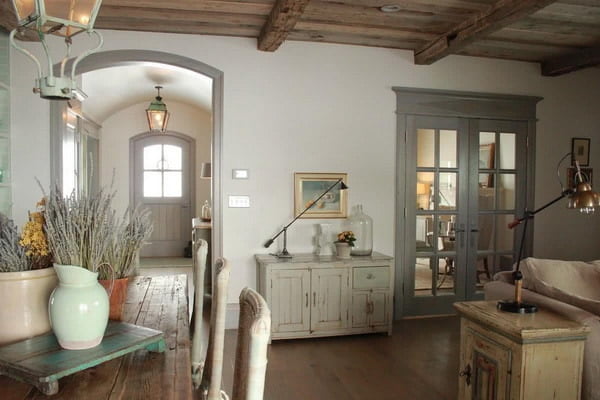
Provence style originated in the French province of the same name, where the fields are adjacent to the sea coast. This rustic style, the most romantic and decorative, is popular in recent years.
- Materials – all natural: from wood to cotton.
- Finish. Brickwork, deliberately rough coating of plaster or paint, aged boards on the floor are striking signs of Provence style finishes. Walls can be decorated with floral wallpaper. Such a contrast of the old and the new creates an interesting decorative effect.
- Furniture. Forged furniture is often used forged and carved elements; and she herself – bright colors. Vintage or grunge furniture is acceptable. Style welcomes furniture decoration with ruffles and ruffles.
- Colors. Provence style involves the use of muted tones. All colors are associated with sunburned or dusty. The style uses shades of white, pink, lilac, beige, green, etc.
- Lighting. To make the room cozy, it must be carefully lit. The main choice is lamps in fabric lampshades, large chandeliers will fit perfectly into the Provence style interior. Windows are covered with multilayer curtains with floral ornaments.
What Are The Styles In The Interior: Modern (Contemporary)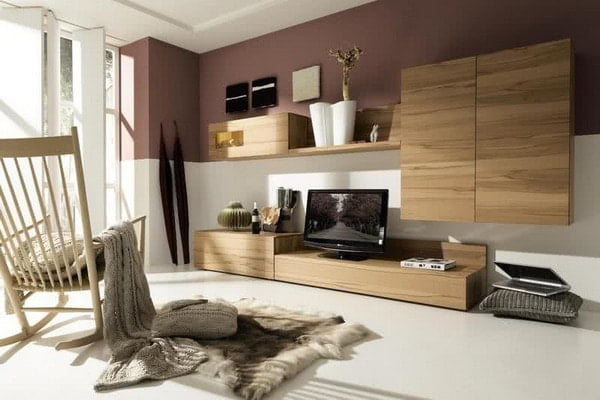
Modern style in the interior originated in the middle of the twentieth century. Its basis was the Scandinavian style, minimalism and constructivism. A small room is an ideal space for design in a modern style, concise and restrained. But modern is not without decorativeness. Affordable things of mass production often become his ornaments. Therefore, the modern interior is eclectic when the apartment is filled with objects from different eras and styles.
The main features that characterize the modern style are simple forms, practicality, maximum freedom in the choice of materials, decorations and colors. A modern interior is created without strict restrictions, the main thing is that the apartment is comfortable for its residents. Also an important feature that modern style took from minimalism is the maximum of free space. The main symptom is the predominance of smooth forms and clean lines. The modern interior does not irritate the eye, does not distract from relaxation or work.
- Furniture.Of particular note is the contemporary furniture style. The architecture and design of the middle of the last century sought to create a comfortable, accessible habitable space. In many respects, the German Bauhaus school contributed to the emergence of these ideas, which promoted a new approach to art, which was fundamentally different from the canons of classics. Architects and designers working at the school sought to create furniture with affordable prices, but stylish and functional. Modern style prefers furniture of light colors without decoration, low and soft form. Often for the manufacture of furniture used transparent plastic, acrylic, glass. The contemporary style welcomes the use of such furniture items as modular or built-in wardrobes, beds with storage systems, armchairs or sofa beds, folding tables, chests of drawers.
- Colors. Modern style mainly uses a neutral color scheme: shades of brown, gray, beige, as well as black and white. Against the background of a strict modern style, bright accents look spectacular: elements of an unusual shape or color.
- Walls and floor. Contemporary style means discreet finishes. Often on the walls – paint or wallpaper in a neutral color, on the floor – light tiles or wood in natural tones. Modern style is enlivened by a variety of textures. So, glossy surfaces (marble, steel, glass) are adjacent to matte (brick, wood, stone). Fanciful forms (niches, stained-glass windows, stucco panels, multi-level ceilings) in the decoration of a modern interior are unacceptable.
- Materials The modern style allows the use of both natural and artificial materials. Their price range is different: from elite wood to linoleum. Neutral modern style often becomes expressive due to textured elements: natural skins, raw stone and wood, rattan.
- Lighting. Modern style in the interior is unthinkable without a well-thought-out lighting system. Both natural and artificial light are important. For a modern interior to be cozy, the fabric of the curtains should not be excessively dense. Translucent curtains or blinds are the optimal and basic option for a room decorated in a modern style. Multi-level lighting, including hidden lighting, are welcome. The modern style of the interior accepts both light fixtures of a simple geometric shape and non-standard. But the modern style is not welcomed by pompous lighting fixtures – chandeliers with crystal pendants, imitation of candles, etc.
- Decor The modern style in the interior is focused on the use of jewelry, important for the inhabitants of a particular space. One striking example is the images of pets, family photos, children’s crafts, and hobbies. Modern style does not imply an abundance of decorative elements of differing shapes and colors. Large large plants also decorate the modern interior and clean the air. But different eclectic decor, which is used sparingly, modern style welcomes. The neutral interior is an ideal base for bold experiments with decorative elements. Thanks to their rich colors and unusual shape, a strict modern style looks more expressive.
What Are The Interiors: Postmodernism Style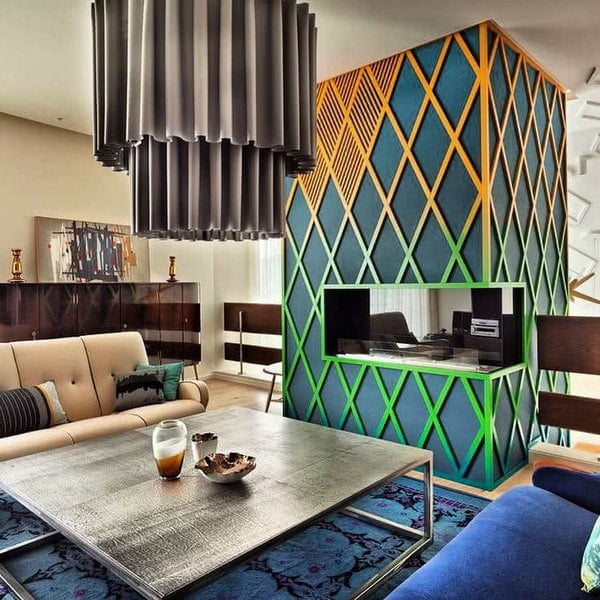
Postmodernism is a collective definition for various areas of art and architecture that appeared in the middle of the 20th century. Postmodernism began to exist as a style that redefined the ideas of modernity and avant-garde.
During this time period, established art and architecture, which were based on rational functionality, began to be perceived as monotonous and monotonous. Postmodernism was designed to return imagery, theatricality, fantasy to art and architecture. At its core, postmodernism is a game, a revision of the old, and not the creation of a new one.
The interior style of postmodernism is characterized by the use of ready-made forms and ideas, synthetics and irony. Despite the extravagance, postmodernism aims to create a harmonious design that combines elements of several styles of architecture and art. The interior in the spirit of postmodernism looks theatrical. A frequent solution for designers working in the framework of postmodernism is the violation of proportions. A vivid example for postmodernism is a small room in the center of which stands a tall column or a fountain murmurs. Although grotesque and illogical, the interior in the spirit of postmodernism is realistic and adapted to life in it. But one main feature of postmodernism, the rejection of everyday life and stereotypes, persists in any conditions. Also in postmodernism dynamic and free forms predominate. Modernism, by contrast,
- The color scheme of postmodernism . In postmodernism, bright and energetic tones are used, as well as all shades of silver and beige. The presence of pearlescent and fluorescent surfaces is another distinguishing feature of postmodernism. Contrasting combinations of colors, textures and shapes distinguish postmodernism from all other styles.
- Walls, floor and ceiling in postmodernism. The style of postmodernism in the interior is characterized by the absence of strict canons in the decoration of the walls. A common option for postmodernism is a neutral tone surface suitable for being a backdrop for bright objects. Postmodernism welcomes decorative elements: niches of an unusual shape, inserts of another made of metal, wood or glass, custom built-in lighting. Basically, the ceiling in postmodernism is monophonic, but multi-level and asymmetrical in shape. In the framework of postmodernism, the floor can be any, the emphasis is only on the functionality of the material used for a particular room.
- Furniture in postmodernism. Postmodernism is distinguished by the use of transformable, as well as any actual furniture models. Within the framework of postmodernism, symmetrical shapes are combined with asymmetric ones, and smooth ones – with geometric shapes. There should not be a lot of furniture, otherwise the already expressive interior in the postmodern style will be overloaded. A common example for postmodernism: one bright piece of furniture that stands out from the rest.
- Decorative elements in postmodernism. Decor items characteristic of postmodernism are designed in the spirit of current trends in art and architecture. Stained glass, fancy figurines, living plants in unusual pots, pillows in bright covers will decorate the interior of postmodernism. But postmodernism is distinguished by such a feature as the moderate use of interior decorations. All elements form a single and harmonious composition, making the interior look holistic. Art objects in the spirit of postmodernism, whether paintings, photos or other images are extravagant and intricate. Postmodernism welcomes the presence in the interior of posters and posters, as well as printed elements.
- Lighting in postmodernism. The lighting fixtures used are diverse: from chandeliers with pendants to halogen lamps. A room in the style of postmodernism is often lit with neon lights that effectively enliven the interior.
- Materials characteristic of the postmodern style. Typical objects in the spirit of postmodernism – made of artificial leather, nickel, chrome, plastic, glass. But postmodern design styles in the interior also allow for more traditional options.

